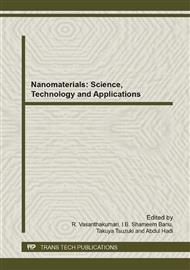[1]
J.J. Went, G.W. Rathenau, E.W. Gorter, G.W. Van Oosterhaut, Phil. Tech. Rev. 13 (1952) 194.
Google Scholar
[2]
H. Jonker, H.P. Wijn, P.B. Braun, Phil. Tech. Rev. 18 (1956) 154.
Google Scholar
[3]
J. Smit, H.P.J. Wijn, Ferrites, Philips Technical Library, Eindhoven, 1956, p.204–207.
Google Scholar
[4]
X.H. Wang, L.T. Li, S.Y. Su, Z.L. Gui, J. Am. Ceram. Soc. 88 (2005) 478–480.
Google Scholar
[5]
J.J. Xu, C.M. Yang, H.F. Zou, Y.H. Song, G.M. Gao, B.C. An, S.C. Gan, J. Magn. Magn. Mater. 321 (2009) 3231–3235.
Google Scholar
[6]
G. Albanese, Journal De Physique, Colloque C1, supplyment au no 4, Tome 38, Avril 1977, page C1-85.
Google Scholar
[7]
L. Jia, Y. Tang, H. Zhang, P. Deng, Y. Liu, B. Liu, Jpn. J. Appl. Phys. 49 (2010) 063001.
Google Scholar
[8]
K. Kamishima, J. Magn. Magn. Mater. 312 (2007) 228–233.
Google Scholar
[9]
M. R. Barati, J. Sol-Gel Sci. Technol. 52 (2009) 171–178.
Google Scholar
[10]
X. Jiao, D. Chen, Y. Hu, Mater. Res. Bull. 37 (2002) 1583.
Google Scholar
[11]
C. Hwang, J. Tsai, T. Huang, Mate. Chem. Phys., 110 (2005) 1-7.
Google Scholar
[12]
C. H. Peng, C. Hwang, S. Chen, Mater. Sci. Eng. B 107 (2004) 295.
Google Scholar
[13]
D. H. Chen, X. R. He, Mater. Res. Bull. 36 (2001)1369.
Google Scholar
[14]
M. Mouallem-bahout, S. Bertrand, O. Pena, J. Solid State Chem. 178 (2005) 1080.
Google Scholar
[15]
A. Verma, T. C. Goel, R. G. Mendiratta, J. Magn. Magn. Mater. 208 (2000) 13.
Google Scholar
[16]
Q. Chen, A. J Rondinone, B. C. Chakoumakos, J. Magn. Magn. Mater. 194 (1999) 1.
Google Scholar
[17]
B. L. Bischoff, M. A. Anderson, Chem. Mater. 7 (1995) 1772.
Google Scholar
[18]
C. C. Wang, J. Y. Ying, Chem. Mater. 11 (1999) 3113.
Google Scholar
[19]
V. J. árik, A. Grusková, J. Sláma, R. Dosoudil, A. González, G. Mendoza, Advances in Electrical and Electronic Engineering (2011) pp.344-346.
Google Scholar
[20]
A. Katoch, A. Singh, International Journal of Enhanced Research in Science Technology & Engineering 2 (2013) 1-7.
Google Scholar
[21]
A.K. Jonscher, Dielectric Relaxation in Solids, Chelsa Dielectrics, London, (1983).
Google Scholar
[22]
M. Hashim , Ceram. Int. 39 (2013) 1807–1819.
Google Scholar
[23]
M.A. El Hitti, J. Magn. Magn. Mater. 164 (1996) 187.
Google Scholar
[24]
A.M. Bhavikatti, International Journal of Engineering Science and Technology 2(11) ( 2010) 6532-6539.
Google Scholar
[25]
M. Penchal Reddy, W. Madhuri, G. Balakrishnaiah, N. Ramamanohar Reddy, K.V. SivaKumar, V. R. K. Murthy, M. Hashim, Ceram. Int. 39(2013)1807–1819.
Google Scholar


